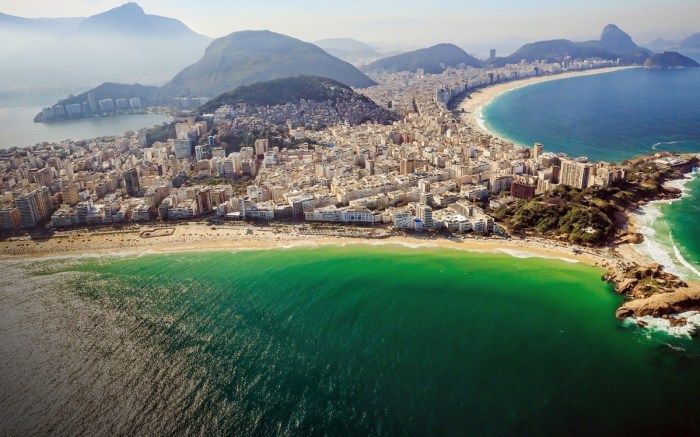Best beaches in Miami – a vibrant tapestry of sun-drenched sands and lively atmospheres. From family-friendly shores to secluded coves, Miami offers a diverse selection of beaches for every taste. This guide delves into the best of Miami’s beach scene, exploring top picks, activities, and essential considerations for your perfect beach getaway.
Miami’s beach culture is deeply rooted in its history, evolving from its early days to the bustling, cosmopolitan destination it is today. We’ll explore the evolution of these iconic spots, examining the different vibes they offer. Whether you crave relaxation, adventure, or a blend of both, this guide will help you discover the perfect Miami beach for your next vacation.
Introduction to Miami Beaches
Miami’s beach culture is a vibrant tapestry woven from diverse threads. It’s a blend of sun-drenched relaxation, lively nightlife, and a constant buzz of activity. From the iconic Art Deco architecture lining Ocean Drive to the laid-back vibes of South Beach, Miami’s beaches reflect the city’s eclectic personality. The historical context of these beaches is deeply intertwined with the city’s growth and evolution, reflecting both its past and its present.Miami’s beaches have evolved significantly over time.
Early development focused on creating accessible, public spaces. As the city grew, so did the range of beach experiences offered, catering to various tastes and needs. This has led to a diverse spectrum of beach types, catering to families, partygoers, and those seeking tranquility.
Types of Miami Beaches
Miami boasts a diverse array of beaches, each with its own unique character. This variety caters to different preferences, from the bustling energy of South Beach to the serene seclusion of some quieter coves. Understanding the distinctions between these types of beaches can help you choose the perfect spot for your Miami beach experience.
Beach Type Comparison
| Beach Type | Location | Atmosphere | Activities | Amenities |
|---|---|---|---|---|
| Family-Friendly | Lummus Park, Haulover Beach, South Pointe Park | Relaxed, safe, and kid-friendly | Swimming, sunbathing, picnics, playgrounds, beach volleyball, and calmer waters for kids. | Lifeguards, restrooms, showers, concession stands, and playgrounds. |
| Party Beaches | South Beach, Ocean Drive | Energetic, vibrant, and lively | Swimming, sunbathing, people-watching, bar-hopping, live music, and water sports. | Numerous bars, restaurants, nightclubs, and entertainment venues; often with live music and events. |
| Secluded Coves | Key Biscayne, Crandon Park | Tranquil, peaceful, and private | Swimming, snorkeling, kayaking, paddleboarding, fishing, and simply relaxing. | Restrooms, limited concession stands, and often fewer crowds. |
Top Recommended Beaches

Miami’s coastline boasts a diverse range of beaches, each offering unique experiences. From vibrant nightlife to tranquil relaxation, the city’s beaches cater to a wide variety of preferences. This section highlights the top 5 most popular beaches, exploring their distinct characteristics and atmospheres.The selection of these beaches is based on factors like popularity, amenities, and overall visitor experience.
Each beach offers something special, from stunning views to exciting activities. Understanding the nuances of each beach can help visitors plan a truly memorable Miami beach trip.
Popular Miami Beach Destinations
Miami’s beach scene is a vibrant tapestry of experiences. Understanding the differences in atmosphere and activities between these top beaches will help you choose the perfect spot for your Miami getaway.
- South Pointe Park Beach: Known for its stunning views of the Miami skyline and Biscayne Bay, South Pointe offers a truly spectacular backdrop for relaxation and photo opportunities. The consistent, strong waves make it a popular spot for surfers and those looking for an active beach experience. The park itself is well-maintained, with ample space for sunbathing, picnics, and simply enjoying the scenery.
- Lummus Park Beach: This beach is a favorite for families due to its calm waters and shallow entry. It’s ideal for young children and those who prefer a more relaxed atmosphere. The park’s facilities include picnic areas, playgrounds, and restrooms, providing a convenient and enjoyable experience for families. The less intense waves also make it a good choice for beginners or those who prefer a gentle swim.
- Haulover Beach Park: This beach stretches along the shoreline, providing an excellent opportunity for a walk or bike ride. Haulover Beach Park’s proximity to the ocean and its natural beauty makes it a must-see. The park offers a diverse range of activities, from swimming and sunbathing to exploring the nature trails.
- Ocean Drive Beach: This beach is famous for its iconic Art Deco architecture and vibrant atmosphere. It’s a great place to soak in the lively energy of Miami Beach, especially during the day. This area is perfect for those who appreciate a blend of relaxation and activity. Visitors will find numerous shops, restaurants, and entertainment options nearby, creating a bustling atmosphere.
- Bal Harbour Beach: Often considered one of the most luxurious beaches in Miami, Bal Harbour is renowned for its pristine sand and calm waters. The refined atmosphere, coupled with exclusive beachfront properties, makes it a sought-after destination for those seeking a high-end, tranquil beach experience. The beach is well-maintained and offers a luxurious atmosphere.
Comparing Beach Atmospheres
The atmosphere of each beach reflects its unique characteristics and caters to different preferences. South Pointe’s powerful waves and cityscape views appeal to thrill-seekers, while Lummus Park’s gentle waves and family-friendly amenities are perfect for those seeking relaxation. Haulover Beach’s natural beauty and walking paths are ideal for nature lovers. Ocean Drive Beach’s vibrant energy and architectural beauty draw in those seeking a bustling atmosphere.
Finally, Bal Harbour’s luxurious environment attracts those seeking a high-end, tranquil escape.
Beach Details
This table provides a concise overview of the top 5 Miami beaches, including their location, average water temperature, and popular activities.
| Beach | Location | Average Water Temperature (°F) | Popular Activities |
|---|---|---|---|
| South Pointe Park Beach | South Pointe Park, Miami Beach | 78-82 | Swimming, surfing, sunbathing, photography |
| Lummus Park Beach | Lummus Park, Miami Beach | 78-82 | Swimming, sunbathing, picnics, family activities |
| Haulover Beach Park | Haulover Beach Park, Miami Beach | 78-82 | Swimming, sunbathing, walking, biking, exploring nature trails |
| Ocean Drive Beach | Ocean Drive, Miami Beach | 78-82 | Swimming, sunbathing, people-watching, shopping, dining |
| Bal Harbour Beach | Bal Harbour, Miami Beach | 78-82 | Swimming, sunbathing, luxury shopping, dining |
Beach Activities and Amenities
Miami’s beaches are more than just sand and sun; they’re vibrant hubs of activity and amenities. From thrilling water sports to casual beachside dining, there’s something for every visitor. Understanding the range of activities and services available can enhance your beach experience, ensuring a memorable and fulfilling trip.Miami’s beach culture extends beyond relaxation. The combination of natural beauty and developed amenities makes it an ideal destination for both leisure and entertainment.
This section details the diverse activities and services available, highlighting the various ways to engage with these popular coastal spots.
Water Sports and Beach Games
Miami’s beaches are renowned for their exceptional conditions, which lend themselves perfectly to a wide array of water sports. From leisurely paddleboarding to adrenaline-pumping jet skiing, the options are plentiful. Beach volleyball, frisbee, and other classic games also contribute to the lively atmosphere.
- Surfing: Miami’s waves, particularly at South Pointe Park, offer opportunities for surfers of varying skill levels. The consistent swells provide a consistent experience for beginners and experienced riders alike.
- Paddleboarding: Paddleboarding is a popular activity that combines exercise with scenic views. The calm waters of many Miami beaches make it an ideal choice for those seeking a more relaxing water experience.
- Jet Skiing: For thrill-seekers, jet skiing offers exhilarating rides across the water. This activity provides a unique perspective of the coastline and the ocean’s expanse.
- Parasailing: Parasailing allows you to take a breathtaking view of the Miami skyline and the surrounding waters. It is an adventurous option for those seeking a different perspective of the beach.
- Beach Volleyball: Many beaches have designated areas for beach volleyball, offering a lively social activity. It’s a great way to engage with fellow visitors and enjoy the atmosphere.
Beachside Amenities
Miami beaches boast a diverse range of amenities that cater to a variety of needs and preferences. Restaurants, bars, shops, and restrooms are strategically placed to enhance the overall experience.
Miami boasts some incredible beaches, but if you’re looking for more than just a day trip, checking out trip ideas for beach vacations in the southern US is a great way to broaden your horizons. Trip ideas beach vacations best beaches in southern offer amazing options, from exploring hidden coves to relaxing on pristine sands. Ultimately, Miami’s beaches remain a top choice for their vibrant atmosphere and stunning views, though.
- Restaurants and Bars: From casual beachfront cafes to upscale dining establishments, Miami beaches offer a plethora of culinary options. These venues provide diverse dining experiences to suit different tastes and budgets. Enjoy fresh seafood, casual fare, or elaborate meals while soaking in the vibrant atmosphere.
- Shops and Vendors: Beachside shops and vendors offer a wide range of souvenirs, beach essentials, and local crafts. These provide an opportunity to find unique treasures and support local businesses.
- Restrooms and Changing Facilities: Clean and well-maintained restrooms and changing facilities are crucial for a comfortable beach experience. These amenities are usually readily available throughout the beach areas.
Activities at Top 5 Miami Beaches, Best beaches in miami
This table summarizes the diverse activities available at five of Miami’s most popular beaches.
Miami’s beaches are undeniably amazing, offering everything from calm turquoise waters to lively boardwalk vibes. However, if you’re looking for a different kind of adventure, check out a hiking guide for Havasu Falls, a breathtaking natural wonder. This havasu falls hiking guide will help you plan your trip, ensuring you get the most out of your experience.
Ultimately, whether you’re seeking relaxation on a Miami beach or a challenging hike, there are fantastic experiences waiting for you!
| Beach | Activity | Description | Location |
|---|---|---|---|
| South Pointe Park | Surfing | Excellent waves for all skill levels | South Pointe Park |
| South Beach | Beach Volleyball | Designated courts for competitive and casual play | South Beach |
| Bal Harbour | Paddleboarding | Calm waters perfect for leisurely paddling | Bal Harbour |
| Crandon Park | Fishing | Excellent fishing opportunities for various species | Crandon Park |
| Haulover Beach | Jet Skiing | Thrilling rides across the water | Haulover Beach |
Considerations for Visitors
Planning your Miami beach trip involves more than just choosing a spot. Understanding the best time to visit, transportation options, and parking availability is crucial for a smooth and enjoyable experience. Knowing these factors beforehand can help you avoid unexpected delays and ensure a relaxing time soaking up the sun and enjoying the vibrant Miami atmosphere.
Best Time to Visit
Miami’s weather is generally pleasant year-round, but the best time to visit for optimal beach conditions and fewer crowds is during the shoulder seasons. Spring (March-May) and fall (September-November) offer pleasant temperatures, sunny skies, and fewer tourists compared to the peak summer months (June-August). Summer brings higher temperatures and increased humidity, which might not be ideal for everyone.
Additionally, the crowds can be significantly larger during these months, potentially impacting your beach experience. Consider your personal preferences and tolerance for heat and crowds when selecting your travel dates.
Transportation Options
Getting to Miami beaches varies depending on your starting point. Driving is a popular option, but parking can be challenging and expensive at some locations. Public transportation, including Metrorail and Metromover, provides convenient access to certain areas. Taxi services and ride-sharing apps like Uber and Lyft are readily available, offering flexibility and door-to-door service. The best transportation option depends on your location and the specific beach you’re visiting.
Parking and Accessibility
Parking availability and accessibility vary considerably among Miami’s beaches. Some beaches, especially popular ones, have limited parking, requiring early arrival or alternative transportation options. Public transportation, while not always direct to every beach, offers a viable alternative to driving, especially in congested areas. Consider using ride-sharing services for ease of access. It’s essential to research parking options for the specific beach you plan to visit beforehand.
For instance, South Pointe Park, a popular spot, can have limited parking, leading to potential congestion.
Safety Tips
Staying safe at Miami beaches is paramount. Be aware of your surroundings, keep valuables secure, and swim only in designated areas. Always be mindful of the weather conditions, especially during summer months, and avoid prolonged exposure to the sun. Check for any local advisories or warnings before heading to the beach, and be cautious of strong currents.
Following these safety precautions can contribute to a worry-free beach experience.
Beach-Specific Information
| Beach | Parking Options | Transportation | Safety Tips |
|---|---|---|---|
| South Pointe Park | Limited parking, arrive early. Street parking may be available but can be difficult to find. | Metrorail to the closest station, then a short taxi or ride-sharing ride. | Be cautious of strong currents, especially during high tide. Swim only in designated areas. |
| Lummus Park | Parking available, but can fill up quickly. Consider street parking. | Metrorail, then a short taxi ride. | Watch for children playing and keep an eye on belongings. |
| Haulover Beach Park | Parking available, but can be crowded. Street parking can be difficult. | Accessible by car, public transportation may require a transfer. | Watch for wildlife, such as seagulls, and keep a safe distance from them. |
Unique Experiences

Miami’s beaches offer more than just sun and sand. Dive into a world of unique experiences, from hidden coves to vibrant festivals, that truly capture the spirit of the city. These experiences go beyond the typical beach day, providing a deeper connection with Miami’s culture and natural beauty.Beyond the bustling shores, you’ll discover a variety of special experiences waiting to be explored.
Miami’s beaches are legendary, right? But before you pack your bags for those perfect sun-soaked days, checking out us airports pandemic travel tips is crucial. Knowing the latest airport protocols and procedures will ensure a smooth trip, so you can fully enjoy the vibrant atmosphere and stunning scenery of Miami’s amazing beaches.
Whether you’re seeking a tranquil escape or an energetic celebration, Miami’s beaches have something to offer every visitor.
Hidden Gems and Secluded Beaches
Miami boasts numerous hidden gems, secluded beaches offering a tranquil escape from the crowds. These pockets of paradise provide an intimate and serene beach experience, perfect for those seeking solitude and natural beauty. Often accessed by walking or taking a short detour, these hidden beaches provide a unique opportunity to connect with the natural beauty of the area.
- Crandon Park Beach, while known for its larger area, possesses sections offering a secluded feel. The calm waters and scenic surroundings provide a relaxing alternative to the main sections of the park.
- Haulover Beach Park, a popular spot, also has quieter areas away from the main entrance. Explore the trails and find a spot that suits your need for solitude.
Special Events and Festivals
Miami’s beaches are a vibrant hub of activity, hosting a variety of special events and festivals throughout the year. These events add an extra layer of excitement to your beach experience, showcasing the city’s rich cultural heritage and vibrant spirit.
- South Beach Wine & Food Festival: This renowned event takes place annually in South Beach, featuring renowned chefs, winemakers, and a diverse selection of culinary experiences. This festival showcases Miami’s vibrant culinary scene and provides a unique opportunity to sample delectable dishes and wines.
- Art Deco Weekend: A popular annual event celebrating Miami’s iconic Art Deco architecture. The vibrant atmosphere, street performances, and unique displays of vintage art, and culture make this event a must-attend for those interested in the architectural and artistic heritage of the city.
Unique Experiences to Book
Many unique experiences are available for booking at Miami beaches, offering a curated and personalized approach to your vacation.
| Experience | Location | Description | Booking Information |
|---|---|---|---|
| Sunset Kayak Tour | Venetian Islands | Enjoy a tranquil kayak tour through the Venetian Islands at sunset. Marvel at the picturesque views and capture the beauty of the golden hour. | Contact local tour operators or check online booking platforms. |
| Private Beach Cabana Rental | South Pointe Park | Enjoy ultimate relaxation with a private beach cabana. These exclusive rentals often include amenities like shaded seating, restrooms, and personal service. | Contact the park or resort directly or use online booking platforms. |
| Dolphin Watching Tour | Biscayne Bay | Embark on a boat tour to spot dolphins in their natural habitat. These tours often provide educational insights into the marine life and their surroundings. | Check with local tour operators for availability and booking options. |
Visual Representation of Miami Beaches: Best Beaches In Miami
Miami’s beaches offer a captivating visual experience, a vibrant tapestry woven from sun-drenched sands, turquoise waters, and the surrounding urban and natural landscapes. The beauty is multifaceted, changing with the time of day and the season. From the golden hues of sunrise to the fiery oranges and purples of sunset, the beaches paint a picture of stunning natural artistry.The visual splendor of Miami’s beaches extends beyond the immediate shoreline.
The interplay of light and shadow, the varying textures of the sand, and the colors of the water create a dynamic and ever-shifting scene. The surrounding architecture, often modern and striking, adds another layer to the visual narrative, highlighting the city’s unique blend of urban and coastal environments.
Sand, Water, and Surrounding Landscapes
Miami beaches boast a variety of sand types. Some beaches have fine, powdery white sand, while others feature a more coarse, golden hue. The water, often a brilliant turquoise or azure, reflects the sky and the surrounding landscape, creating an almost ethereal glow. Palm trees, swaying gently in the breeze, and lush greenery line the coast, providing a natural frame to the beach scenes.
Buildings, sometimes art deco masterpieces, and other structures, blend seamlessly with the natural beauty. This harmonious combination of man-made and natural elements creates a unique and memorable visual experience.
Typical Beach Scenery
The beach scenery transforms throughout the day. At sunrise, the sky is often painted with soft pinks, oranges, and yellows, casting a warm glow over the sand and water. As the sun climbs higher, the light intensifies, highlighting the textures of the sand and the variations in the water’s color. By midday, the beach is vibrant and alive with activity, the sun’s rays creating dazzling highlights on the water.
The late afternoon brings a change again, as the sky begins to take on warmer, richer tones, culminating in a breathtaking sunset.
- Sunrise: The sky transitions from dark to light, showcasing a gradual spectrum of colors from deep indigo to pale peach and rose. The water reflects these hues, creating a serene and magical ambiance.
- Midday: The sun is high, casting strong shadows and creating a vibrant atmosphere. Beachgoers are typically more active, with families enjoying the sand and water. The light is intense, with a stark contrast between the bright sand and the deeper shades of the water.
- Sunset: The most dramatic moment, often featuring a breathtaking display of color. The sky takes on fiery oranges, deep purples, and fiery reds, as the sun dips below the horizon. The water shimmers with these colors, creating a mesmerizing spectacle.
Colors, Textures, and Sounds
The colors of Miami beaches are as diverse as the sand and water. From the warm hues of the sand to the brilliant blues and greens of the water, the palette is rich and varied. The textures of the sand range from smooth and fine to coarse and grainy. The sounds of the beach are equally captivating, from the gentle lapping of waves to the cries of seagulls and the chatter of beachgoers.
Atmosphere and Ambiance by Season
Miami’s beaches offer a unique atmosphere at different times of the year. In the summer, the air is warm and humid, and the beaches are bustling with activity. In the winter, the weather is more pleasant, and the beaches are often less crowded.
“The sun dipped below the horizon, painting the sky with hues of fiery orange, deep crimson, and molten gold. The sand, warmed by the day’s sun, shimmered under the vibrant light. Waves, kissed by the setting sun, gently lapped against the shore, creating a mesmerizing symphony of sound and color.”
Last Word
In conclusion, Miami’s beaches offer a remarkable variety of experiences, from the lively energy of South Beach to the tranquility of secluded coves. This comprehensive guide provides insights into the best beaches, activities, and essential information to help you plan an unforgettable trip. Whether you’re seeking a relaxing day, an exhilarating water sport, or a vibrant social scene, Miami’s beaches have something to offer everyone.
Remember to factor in weather, crowds, and accessibility when choosing your perfect beach destination.



























